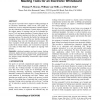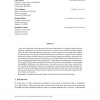178 search results - page 21 / 36 » Representing social structures in UML |
SE
2010
13 years 10 months ago
2010
: In this paper I explain the benefits of projectional language workbenches for product line engineering. The ability to extend programming languages with domain specific concepts,...
CSCW
1998
ACM
14 years 26 days ago
1998
ACM
Our goal is to provide tools to support working meetings on an electronic whiteboard, called Tivoli. This paper describes how we have integrated structured “domain objects” in...
JAIR
2008
13 years 8 months ago
2008
It is well-known that acting in an individually rational manner, according to the principles of classical game theory, may lead to sub-optimal solutions in a class of problems nam...
ILP
1999
Springer
14 years 27 days ago
1999
Springer
Most real-world data is heterogeneous and richly interconnected. Examples include the Web, hypertext, bibliometric data and social networks. In contrast, most statistical learning...
CP
2009
Springer
14 years 9 months ago
2009
Springer
This paper presents a new way of formalizing the Coalition Structure Generation problem (CSG), so that we can apply constraint optimization techniques to it. Forming effective coal...


